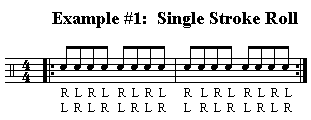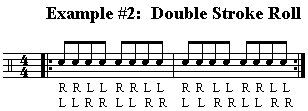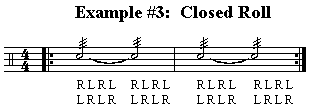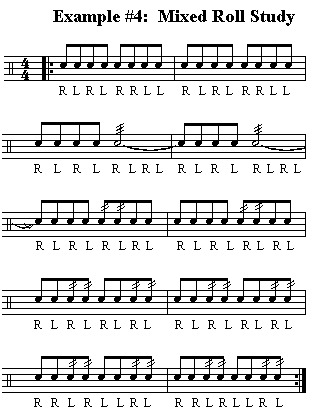Rolls, Rolls, Rolls
This article was written in response to requests asking for a lesson on the closed roll. I've taken it a step farther and decided to cover all three types of rolls: Single stroke, double stroke, and closed rolls.
Three Pressures
It takes three slightly different types of "pressure" to produce each of the three rolls. By
practicing the exercises that follow, you'll be able to develop the ability to seamlessly switch from one roll
to the next. My approach to technique uses the Gladstone system, which is beyond the scope of this article.
But if you would like to learn the basics of that system, see my three-part series Building Monster
Chops in the sidebar.
Single Stroke Roll
Example #1 shows the single stroke roll.

As you can see, it consists simply of single strokes alternating with each hand. The pressure involved in playing a single stroke roll is almost non-existent. You simply throw the stick down toward the drum and let the stick bounce back and return to the initial starting position. Practice playing the exercise slowly and gradually increase the speed, stopping the moment you begin to feel muscle tension. Then, slow down a bit and continue practicing at a slower, relaxed speed. This is your control speed.
With regular practice, you'll be able to increase your control speed and play single strokes at a fast rate of speed without developing tension.
Double Stroke Roll
Example #2 shows the double stroke or open roll. There are actually two ways to play open rolls: The clean
(military or rock) way and the dirty (jazz) way.

Here's how to play doubles the clean way: Throw your right stick down toward the pad as in the single stroke roll except when the stick comes back up, use only your fingers to play the second tap. Do this alternating both hands and you have the clean, military style open roll.
The only difference between the clean and the dirty (jazz) version, is that you don't use your fingers to produce the clean second tap. Instead, you just let the stick sort of bounce on its own. This gives the open roll a loose, jazz sound as opposed to an exact military sound.
Again, gradually increase the speed until you feel tension. Then, slow down a bit and continue practicing at your control speed.
As with the single stroke roll, you'll eventually able to play both versions of the double stroke roll at a fast rate of speed without developing tension.
Closed Roll
Also known as the crush, buzz, or press roll, this requires a third type of pressure. See Example #3.

Approach this roll in the same way you play a single stroke roll except that each time you throw a stick down toward the pad, apply enough pressure on the stick to cause it to bounce multiple times, creating the distinctive buzz sound.
The feeling is one of crushing the stick into the drum, hence the name crush roll. The trick is to start playing the left hand buzz roll just before the right hand buzz sound stops and continue that motion for the duration of the roll.
Once you perfect this, you'll be able to produce the beautiful, seamless buzz roll that sounds like someone tearing a sheet of sandpaper.
Putting Them All Together
Although it may not be difficult for you to play each of these rolls separately, it takes lots of practice to
be able to move smoothly and cleanly from one roll to another. It also makes for a great exercise, as your
hands get a workout using all three types of pressure.
In example #4 I've given you a 10-bar exercise to practice. I'm sure you can come up with many similar examples on your own.

Practice the exercises shown in Example #4 slowly, gradually increasing the speed until you are easily able to play them at top speed.
Note that beats three and four in the third and fourth measures, beat three in the fifth and sixth measures, and the beats of two and four in measures seven through ten are played as closed rolls.
What do I consider to be a good speed for the exercises in example #4? I would shoot for quarter-note equals 200 on the metronome.
If you'd like some good books for further roll study, see the first three entries in the sidebar.
Keep practicing and stay loose.
